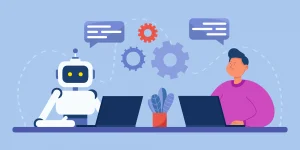Open AI’s Chat GPT has taken the world by storm, quickly gaining widespread attention and reaching over 1 million users in a short period of time.
On November 30, 2022, ChatGPT was released by San Francisco-based OpenAI, a startup that conducts AI research. Whisper, an automatic speech recognition system, and DALLE•2, a well-known AI image and art generator, were also produced by OpenAI.
What is Chat GPT?
The language processing tool Chat GPT, developed by OpenAI, enables users to converse with a computer program in a natural language, such as English. It makes use of the Generative Pre-trained Transformer 3 (GPT-3) language model, which can produce text that resembles what a human writer would produce after being trained on a sizable amount of internet data.
Because the program has been trained by artificial intelligence and machine learning, it is useful for presenting information and responding to inquiries in a similar manner to that which would take place in a typical discussion.
Search engines, in contrast, are web-based tools that help people find information on the internet by using algorithms that crawl and index web pages and rank the search results according to relevance and authority.
Previous versions of GPT-3 had limitations, AI was unable to provide fresh information or provide answers to some questions. As a result, users frequently needed to modify their instructions in order to connect with the AI more effectively. However, rather than requiring the user to clarify their question, it would be more effective if the AI could ask for clarification in a conversational manner. Chat GPT is currently developing in this direction in an effort to enhance the AI’s comprehension of and responsiveness to human requests.
Read: TikTok Trends 2023 – ‘What’s Next’ Report Launched for marketers
Pros and Cons of Chat GPT:
Pros of Chat GPT:
- Chat GPT offers human-like responses, making it feel as though users are communicating with an expert.
- The responses provided by Chat GPT are concise and to the point, making them easy to understand and follow.
- Chat GPT can function as a virtual assistant, helping users with various tasks and answering their questions.
- With text prompts, users can adjust the responses provided by Chat GPT to better suit their needs.
Cons of Chat GPT:
- Chat GPT’s knowledge is limited to the data it has been trained on, which is cut off till 2021, it can’t provide information beyond that.
- There may be issues with the accuracy of Chat GPT’s responses, which can lead to confusion or frustration for users.
- Chat GPT does not have access to the internet, so it cannot provide real-time information or access to external sources.
- Chat GPT may have a lack of variation in its replies, which can make it feel repetitive or unengaging.
- The use of Chat GPT may not be free forever, which could limit accessibility for some users.
Chat GPT Vs Google
The excitement about OpenAI’s Chat GPT has led to parallels between Google’s ability to produce pages and pages of links relating to user questions and long-tail keywords, and the AI bot’s ability to deliver crisp human-like responses to hard topics. Chat GPT can comprehend human language and provide conversational responses since it has been educated on trillions of words from the Internet.
Conclusion
Chat GPT is just the start. Its outstanding usability will undoubtedly usher in a new era of search engines. As AI-powered bots advance, there may be an opportunity to dramatically improve the capacity of specialized search engines to offer reliable and timely information. These engines might also produce various results, enabling users to select pertinent information and judgments.


